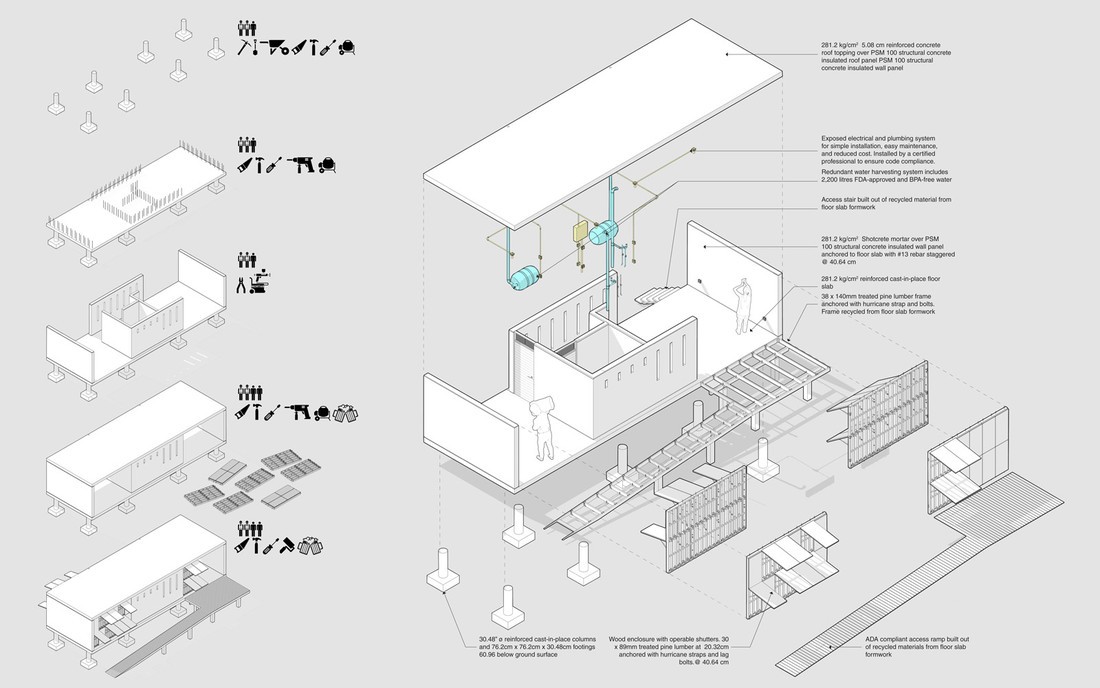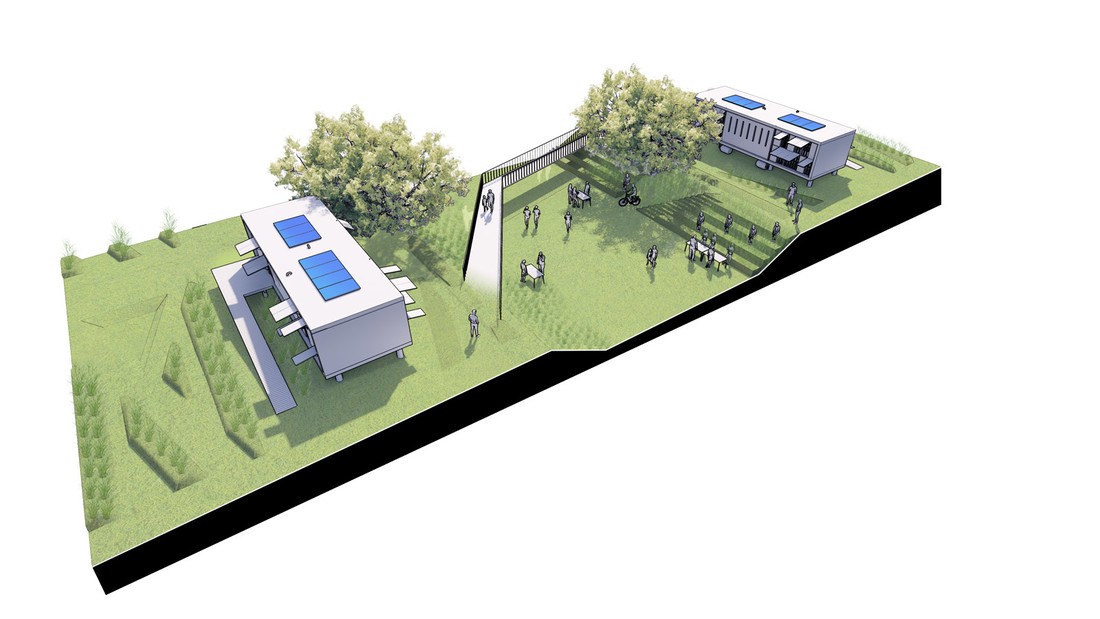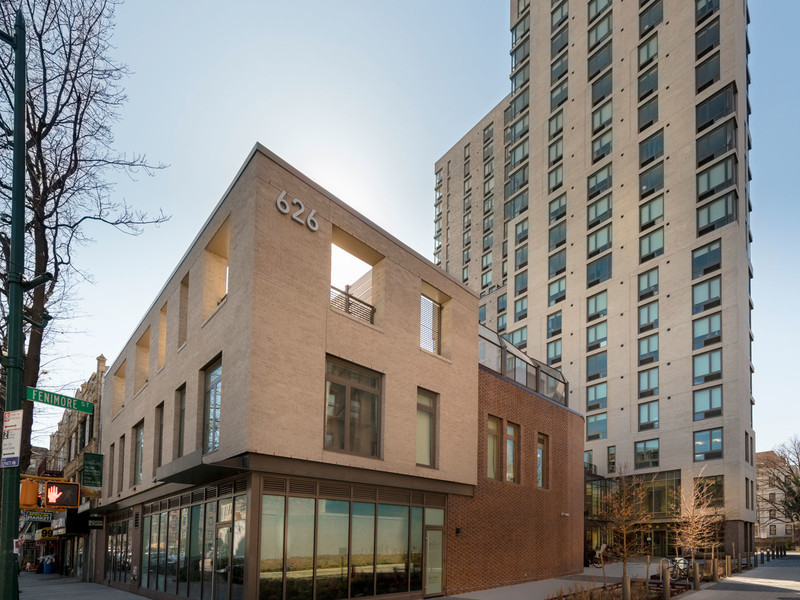
Moriviví House
Marvel's culturally-sensitive, readily-adaptable home provides residents with physical and psychological comfort before, during and after natural disasters. Designed to maximize structural stability yet minimize energy and water usage, it is built with local components that promote ease of assembly, leave space for creative expansion and foster ownership by way of customization. These materials and their integration support local manufacturers and tradesmen, and the simplicity of their assembly encourages homeowners and neighbors to work together on the construction of their neighborhood.

Modularity
The 574 square foot house consists of two principal spaces conjoined by a functional core for the kitchen, bathroom, and infrastructure. A basic 4’ x 8’ module dictates the rectangular plan and elevations, establishing the dimensioning for concrete formwork, exterior envelope panels, and screening elements. Using repetitive modular units that are light, manageable, and based on standard dimensions helps reduce material use, waste and labor costs while minimizing the need for specialized equipment and tools.

Passive strategies
Taking cues from tropical architecture, a narrow footprint and highly permeable facades guarantee maximum light and air circulation throughout. Building orientation limits western exposure while maximizing it towards prevailing northeastern winds. Modular wood screens with operable shutters function as awnings to provide shade and generous amounts of cross-ventilation. These strategies, coupled with the structure’s insulated-panel exterior walls, greatly reduce the need for active systems to provide thermal comfort and artificial lighting.

Off the ground
Elevating the structure on posts minimizes disturbance of the natural terrain and places the house above flood level. The elevated slab also promotes cross-ventilation and helps to mitigate wind pressure on exterior walls.

Systems
Regional materials and methods enable the structure’s cost effectiveness. Familiar concrete and wood building systems simplify construction, minimize detailing, and foster labor force expansion and development. Repetitive modular units that are light, manageable, and based on standard dimensions reduce labor costs and minimize needs for specialized equipment. Minimal finishes and exposed infrastructure lower maintenance and repair costs. When executed with owner-driven construction and community participation, the home helps to create and strengthen local economies.

Wood Shutters
All connections within the reinforced wood structure are made with hurricane straps and bolts. On the floor slab, the reinforced wood is anchored with lag bolts every 40.6 cm. Within the walls, the proposed distance between wooden studs is 20.32 cm, which exceeds the
required separation distance of 60.96 cm. Over each opening, a permanent shutter/ cover can be operated easily with lift support struts. The closing system for the shutters consists of a rope tied to an eyebolt.

Formal variations
The house’s simple distribution and reliance on familiar building techniques facilitates further modifications or expansions as desired by the occupant to suit their needs. Although developed for Puerto Rico, the proposed design will work well in other tropical areas affected by heavy rainfall, winds, and earthquakes. Solid walls could be made of concrete block, clay bricks, or compacted earth. Screens and shutters could be made through a combination of bamboo, woven lattices, and corrugated metal. The floor could be concrete or stone over an elevated compacted earth pad. These options provide economic and logistical flexibility to the owner. We designed this structure with the aim of teaching resilient construction techniques and facilitating community-building for those involved in its construction process. These lasting skills and relationships will foster a culture in which resilient development is both standard and expected.

Functional variations
The open-source design creates opportunities and can be adapted to include non-residential uses, such as home businesses or community support facilities.
These flexible spaces recognize the potential of informal economies, create jobs, and foster the exchange of goods and services within the immediate community. By doing so, the design promotes sustainable economic development.

Sociability, community
The design recognizes that privacy, sociability, and community collaboration are extremely important in a time of crisis. Porches extend the interior living areas to become a key component to promote community interaction, while façade screens can be modulated to provide varying levels of privacy to the occupants. At the scale of the site, infiltration basins and interconnected walkways provide a flood-resistant network for sharing comfort and resources, while serving as gathering areas to tie a collection of homes into a thriving community. When executed with owner-driven construction and the participation of neighbors, the individual houses and common grounds help strengthen local economies and promote community integration.

Site and landscape
Passive strategies extend beyond the house to site-wide systems for temperature control, food production, and water management. A canopy of trees provides shade and thick ground planting minimizes reflection of light into the house. Fruit trees populate the sunnier south side, while storm-resistant tubers are located to the north. Priority is given to native plants that require minimal watering and to species that support each other and repel insects, minimizing the need for intensive maintenance and pesticides. A rain garden collects excess water for reuse, cools incoming breezes, and prevents flooding.
- Location
- Caribbean
- Typology
- Residential, Resilient, Residential Affordable
- Size
- 574 SF
- Design Team
- Jonathan Marvel, Jose R. Marchand-Sifre, Guillermo Marrero, Enrique Ramon, Sabdiel Diaz, Karen Cuadro, Jan Curet, Vernette Velez, Rafael Ferrer, Eckart Graeve, Carolyn McShea
- Consultants
- José Espinal Vázquez Asociados, Structural Engineer
- Awards
- AIA Florida/Caribbean Honor Award for Sustainable Design
- Rendering Credits
- Marvel Architects




